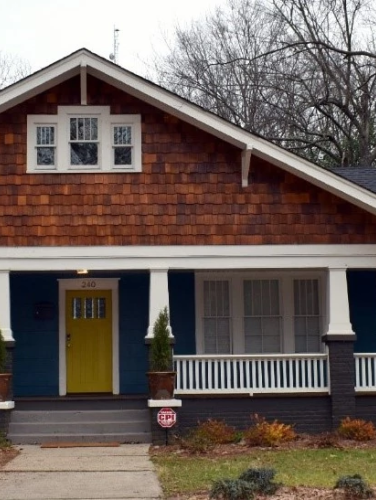
Butler House
(ca. 1925)
The Craftsman styled Butler House evidences the history of a now-illegal racially discriminatory practice known as redlining.
240 Sylvania Ave., Charlotte, NC 28206
The Butler House is one of the best extant examples of the Craftsman bungalow in the Lockwood neighborhood, originally developed as Locke Wood in 1915. As part of Lockwood’s second wave of development initiated by the Ford Motor Company’s early 1920s announcement of plans for a plant on nearby Statesville Avenue, the Butler House represents the history of an early twentieth-century north Charlotte development impacted by 1930s redlining policies. Those policies, later outlawed for their racially discriminatory impact, saw the neighborhood shift demographically from a majority-White to a majority-Black neighborhood following Charlotte’s urban renewal campaign of the 1960s and 1970s.
Property Quick Links
The Butler House is named for its first owner, Arthur C. Butler (1862-1936), a Charlotte native known for his mechanical skills and employed for nearly two decades as the master mechanic of the Charlotte’s Ford Motor Company plant. Before joining Ford’s first plant on East Sixth Street in 1915 or 1916, Butler worked as an engineer for several companies, including North Carolina’s first electric light plant (the Thomson-Houston Company). When Ford announced its new plant, Butler – like many other Ford employees – bought land in Lockwood to be closer to work, but the plant closed between 1927 and 1928 due to intense competition within the auto manufacturing industry. Later, because of stock market crash and ensuing Depression, Bishop lost ownership of the house.
In an effort to stabilize the national housing market, the U.S. government formed the Home Owners’ Loan Corporation to issue bonds to buy and refinance residential mortgages and rate properties based on neighborhood characteristics. In 1937, HOLC appraisers produced a city map of Charlotte based on the likelihood of prospective homebuyers receiving loans for specific neighborhoods. As a working-class neighborhood adjacent to industrial areas, Lockwood received a C (“Definitely Declining”) rating. That rating skewed Lockwood’s residential composition. Older house like the Butler House became duplexes and new construction focused almost exclusively on multi-family dwellings, most of which became rental properties. Absentee landlords led to deteriorating housing conditions and declining rental rates.
When Charlotte’s urban renewal campaign targeted Second Ward’s primarily-Black Brooklyn neighborhood for demolition, displaced residents sought housing wherever available, often moving adjacent to historic White neighborhoods like Lockwood and prompting prejudice and fear that resulted in a “White flight” to suburban areas. As more housing became available in Lockwood, its residential profile changed, but the failure of absentee landlords to maintain housing conditions for their new tenants did not. By 2010 Lockwood had been declared one of the nation’s twenty-five most dangerous neighborhoods. However, the efforts of neighborhood activists, reflected in the restoration of the Butler House, are working to revitalize Lockwood and stem the gentrification that often pushes lower income residents from older urban neighborhoods.

